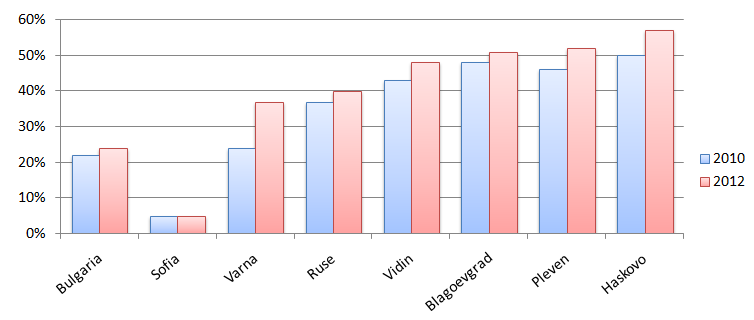Half of the People Working Outside the Capital Are Insured on the Minimum Threshold
Petar Ganev
Talks on changes in the social security system have started again, against the background of continuing protests in the country and the news of a possible budget revision. We have been hearing all kinds of extravagant and even unconstitutional suggestions, such as the proposal to “take away” money from the private pension funds, but yet again little attention is being paid to the influence of minimum insurance thresholds on employment levels in the country. Let’s not forget that neglecting this topic is an invariable criticism in the reports and statements of the EC[1] and the IMF[2]. We now have access to more data, which clearly show the size of the problem and have not been publicly available until now.
In the past year we published an analysis of the effects of social security and regulatory burdens on the labour force in the country. For the first time, using detailed data, we can prove that one out of every four people is insured on or close to the minimum threshold. Now, thanks to the work done by our colleagues from National Social Security Institute, we have 2012 data and a breakdown by regions[3]. It has been pointed out analytically more than once that this problem is mainly on regional level, but never before have had access to detailed regional data. And the statistics are more than alarming.
As expected, such a problem is more or less non-existent in Sofia – only 5% of those working in the capital are insured on or close to the minimum social insurance income. In other words, wages in Sofia are relatively high and raising the minimum insurance thresholds does have a serious influence. But the situation in the country is different. In Haskovo for example, almost 60% of all workers are insured on or close to the minimum. This means that raising the minimum thresholds automatically makes the labour of more than half of the employed in Haskovo more expensive, which inevitably pushes employment down.
Insured on or close to the minimum threshold (% of the insured by regions, 2010 – 2012)

Source: NSSI
*Data of the NSSI for the 16 economic activities for the period 2010 – 2012 have been used, which encompasses almost 1 million insured persons. We assumed insured persons on or close to the minimum to be all those, who are insured on or close to the threshold – with a tolerance range of 10% above the administratively specified threshold.
The same is true for other regions as well – in Blagoevgrad, Vidin, and Pleven 50% of the workers are insured close to the minimum. In Ruse and Varna, 40% are close to the minimum. In other words, if we exclude Sofia, minimum insurance thresholds play a crucial role in the country, because every change in them automatically influences at least half of the employed. Even more, in the past several years, the impact of the minimum thresholds is increasing. Varna was hit the hardest – in 2010 25% were close to the minimum thresholds, while in 2012 these were already close to 40%.
All of this is not quite surprising and just confirms the arguments already expressed. The system of minimum insurance thresholds has immense influence in the countryside, which is neglected in view of Sofia. The blind raising of minimum thresholds in times of crisis and decreasing employment has made it so that more than half of the employed in the country (excluding Sofia) are insured on or close to the minimum and every increase in these thresholds automatically depresses employment levels in many regions. This is one of the explanations behind the problems on the labour market and the lack of new jobs, which is also confirmed by international observers and institutions and the detailed regional data. Inexplicable is the desire of the institutions to comment on all kinds of topics, including unconstitutional ones, but persistently avoid all criticism against the system of minimum insurance thresholds and its effects on employment.
[1] The position of the EC (here): “… To reevaluate the minimum insurance thresholds, in order to make sure that the system does not raise the cost of hiring low-skilled workers too much…”
[2] The position of the IMF (here): “… The effect of the higher minimum wages and minimum social security threshold on employment must also be evaluated…”
[3] Data of the NSSI for the 16 economic activities for the period 2010 – 2012 have been used, which encompasses almost 1 million insured persons. We assumed insured persons on or close to the minimum to be all those, who are insured on or close to the threshold – with a tolerance of 10% above the administratively specified threshold.
�
The project "Regional Profiles: Indicators of Development" is carried out with the support of the America for Bulgaria Foundation.

